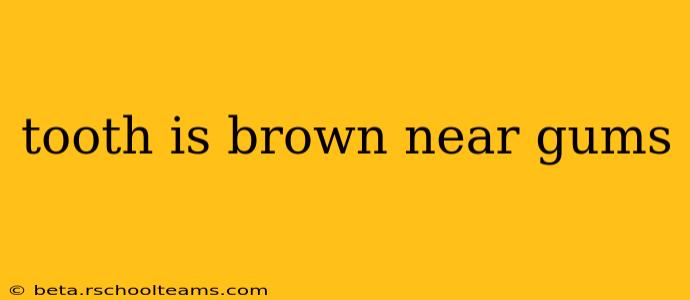Have you noticed a brown discoloration near the gum line of one or more of your teeth? This is a common concern that can stem from various causes, ranging from harmless surface stains to more serious underlying issues. Understanding the potential reasons behind this discoloration is crucial for addressing it effectively and protecting your oral health. This article will explore the common causes of brown teeth near the gums, helping you understand what might be happening and when to seek professional dental care.
What Causes Brown Discoloration Near the Gum Line?
Several factors can contribute to brown staining near your gum line. These range from simple surface stains to more significant dental issues. Let's delve into some of the most common culprits:
1. Food and Drinks:
Darkly pigmented foods and beverages like coffee, tea, red wine, and berries are notorious for staining teeth. These stains often accumulate near the gum line due to proximity and prolonged contact. Good oral hygiene practices, including regular brushing and flossing, can help minimize staining from these sources.
2. Tobacco Use:
Smoking and chewing tobacco significantly increase the risk of tooth discoloration, particularly near the gum line. Nicotine and tar from tobacco products can deeply penetrate tooth enamel, leading to persistent brown staining that's difficult to remove with at-home methods.
3. Poor Oral Hygiene:
Insufficient brushing and flossing allow plaque and tartar to build up along the gum line. This buildup can contribute to discoloration as bacteria produce pigments that stain the teeth. Regular, thorough cleaning is crucial for preventing this type of staining.
4. Medications:
Certain medications, particularly those containing tetracycline antibiotics, can cause discoloration of the teeth, especially during tooth development in children. This discoloration often appears as a brown or yellowish band near the gum line.
5. Dental Fluorosis:
Excessive fluoride intake during tooth development can lead to dental fluorosis, causing white or brown spots or streaks on the teeth. While often mild, severe cases can result in significant discoloration.
6. Age:
As we age, the enamel on our teeth naturally thins, making the underlying dentin (the yellowish layer beneath the enamel) more visible. This can contribute to a slight yellowing or browning of the teeth, often more noticeable near the gum line.
What if the Brown Discoloration is Severe or Accompanied by Other Symptoms?
While many causes of brown teeth near the gums are relatively benign, some situations require professional dental attention. If you notice the discoloration is severe, rapidly worsening, or accompanied by other symptoms such as:
- Gum recession: This exposes more of the tooth's root structure, which is naturally darker and more prone to staining.
- Gum bleeding: This could indicate gum disease (gingivitis or periodontitis).
- Tooth sensitivity: Brown discoloration may be a sign of tooth decay or enamel erosion.
- Pain or discomfort: This warrants immediate dental attention.
You should schedule an appointment with your dentist for a proper diagnosis and treatment plan.
How Can I Prevent Brown Teeth Near the Gums?
Prevention is key to maintaining healthy, bright teeth. Here are some tips to reduce your risk of brown discoloration:
- Practice excellent oral hygiene: Brush twice daily with fluoride toothpaste and floss regularly.
- Limit consumption of staining foods and beverages: If you do consume these items, rinse your mouth with water afterward.
- Quit smoking or chewing tobacco: These habits significantly increase the risk of tooth staining and gum disease.
- Visit your dentist regularly: Professional cleanings can remove surface stains and detect any underlying dental problems early.
Can I Whiten Brown Teeth at Home?
While some at-home whitening products might lighten minor surface stains, they are often ineffective against deep discoloration caused by factors like tetracycline staining or age. It's always best to consult your dentist before attempting any at-home whitening treatments, as inappropriate use can damage your enamel and worsen existing dental problems. Your dentist can assess the cause of the discoloration and recommend the most effective and safe treatment option. They may suggest professional whitening treatments for optimal results.
This information is for general knowledge and does not constitute medical advice. Always consult with a qualified dental professional for diagnosis and treatment of any oral health concerns.
